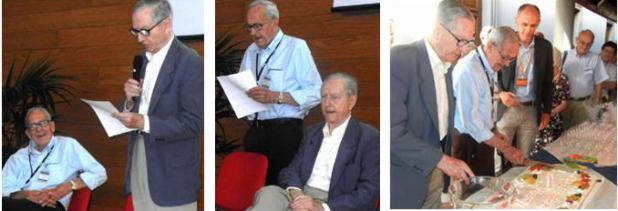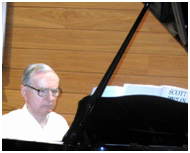Report: Half-a-century of Travel of the Judd-Ofelt Theory
Lidia Smentek
Time: August 26-31, 2012
Place: Udine (Italy)
Venue: ICfE-8, 8th International Conference on f-Elements (http://icfe8.uniud.it/)
On August 1, 1962, two important papers were published:
Phys. Rev., 127, 750 (1962) by B. R. Judd
J.C.P., 37, 511 (1962) by G. S. Ofelt
Both publications were devoted to the theoretical description of the amazing spectroscopic properties of tri-positive lanthanide (rare earth) ions. These ions, when embedded in various materials, bulk or nanoscale, over the years have revolutionized science, technology, medicine and even had an impact on everyday life.
Indicative of the importance of these elements is the recent announcement of a $120 million US Department of Energy project to establish in Ames (Iowa) a new research center for developing methods of rare earth production. (http://www.bbc.co.uk/news/technology-20986437).
These two papers are the origin of the Judd-Ofelt (J-O) theory that describes the electric dipole transitions between the energy levels of 4fN configurations of the lanthanides. These transitions, forbidden by parity selection rules in zeroth order, are regarded as forced by the crystal field generated by the surrounding ligands. The original theory is based on perturbation theory and is defined within single configuration and free ionic system approximations, with the crystal field potential as a perturbation. The J-O approach to the f↔f electric dipole transitions has turned out to be a very powerful tool, and in fact the only one, for the reproduction of the observed spectroscopic patterns. This is especially true when a semi-empirical procedure is applied for its one particle parameterization scheme of f-spectra.
The late Brian G. Wybourne (one of the founders of lanthanide spectroscopy), on the occasion of the 40th anniversary of the J-O theory celebrated in 2003 at the Conference in Lądek Zdrój (Poland), wrote:
“The Judd-Ofelt theory marked a turning point in our understanding of the fascinating spectroscopic properties of the rare earths. It has been, in a very real sense, the first step in the journey to an understanding of the rare earths and their much heavier cousins, the actinides, but like many journeys into the unknown, the end is not in sight”
At ICfE-8, organized in Udine at the end of August 2012 the Golden Anniversary of the J-O Theory was celebrated.
The importance of the J-O Theory is illustrated in the figure below by the growing number of citations over the half century since its formulation. (The last bar on the drawing below covers only half of 2012.)
 Behind the scientific value of the J-O Theory that cannot be overestimated, is a story that makes the origin of the field more colorful than might be expected from reading the publications. Brian Wybourne (Copernicus University, Toruń, Poland) with the assistance of Brian Judd (Johns Hopkins University, Baltimore) succeeded in finding George Ofelt who had been missing from the lanthanide stage for almost 40 years. Nobody in the field had contact with George, who after completing his Ph.D. under the supervision of Wybourne (late fifties and early sixties) left Johns Hopkins to where Brian Judd had moved from Berkeley. Finally in 1998 George was found, and only at that time did he learn from Brian Wybourne that he shares fame with Brian Judd, and that there is in the literature of the field a theory named after him that is based in part on his Ph.D. research. The additional fact that Brian Judd and George Ofelt had never met personally was a challenge in trying to arrange their first meeting. On Sunday June 22, 2003 a historical meeting took place in Lądek Zdrój, Poland, where the traditional school 4th International Spring Workshop on Spectroscopy, Structure and Synthesis of Rare Earth Systems was organized.
Behind the scientific value of the J-O Theory that cannot be overestimated, is a story that makes the origin of the field more colorful than might be expected from reading the publications. Brian Wybourne (Copernicus University, Toruń, Poland) with the assistance of Brian Judd (Johns Hopkins University, Baltimore) succeeded in finding George Ofelt who had been missing from the lanthanide stage for almost 40 years. Nobody in the field had contact with George, who after completing his Ph.D. under the supervision of Wybourne (late fifties and early sixties) left Johns Hopkins to where Brian Judd had moved from Berkeley. Finally in 1998 George was found, and only at that time did he learn from Brian Wybourne that he shares fame with Brian Judd, and that there is in the literature of the field a theory named after him that is based in part on his Ph.D. research. The additional fact that Brian Judd and George Ofelt had never met personally was a challenge in trying to arrange their first meeting. On Sunday June 22, 2003 a historical meeting took place in Lądek Zdrój, Poland, where the traditional school 4th International Spring Workshop on Spectroscopy, Structure and Synthesis of Rare Earth Systems was organized.
That Sunday Judd, Ofelt and Wybourne met. Only Brian Wybourne knew the other two, since he was part of the process of the development of the theory in the early sixties.

L to R, Brian Judd, George Ofelt and Brian Wybourne in Lądek Zdrój together for the first time.
Nine years have quickly passed since this historic meeting! The Golden Anniversary of the J-O Theory was celebrated in Udine in 2012, and both guests of honor, Brian Judd and George Ofelt, were present to share their memories with the audience, among whom some attendees were at least two generations their junior. The idea behind this celebration was to connect those who established the origin of the field half a century ago with the next generation is contributing to the explosion of scientific achievements based on the Judd-Ofelt Theory.
Celebration of the golden anniversary had two parts, a regular conference session devoted to the theory and spectroscopy, and a festive and moving birthday celebration. There were congratulations, and shared memories, photographs from the past, and personal memoirs of those who were unable to be present. As at the 40th anniversary, there was a concert, performed just after the birthday cake with candles for the guests of honor to blow out, and a champagne toast.

George Ofelt (left) and Brian Judd sharing own memories, and then cutting the birthday cake

 The Judd-Ofelt concert: Brian Judd at the piano and Sterling Yco playing flute
The Judd-Ofelt concert: Brian Judd at the piano and Sterling Yco playing fluteI would like to thank Alessandro Trovarelli (Università di Udine, Italy) and Marco Bettinelli (Università di Verona, Italy), the main organizers of the ICfE-8 in Udine, for giving me carte blanche for organizing this birthday celebration. My gratitude is addressed also to Oscar Malta (Universidade Federal de Pernambuco, Recife, Brazil) and Gerd Meyer (Universität zu Köln, Germany) for their support and encouragement.
Lidia Smentek (Lidia.Smentek@Vanderbilt.edu) retired after four decades at Nicolaus Copernicus University (Toruń, Poland) and is a Professor at Vanderbilt University.
Disclaimer - The articles and opinion pieces found in this issue of the APS Forum on International Physics Newsletter are not peer refereed and represent solely the views of the authors and not necessarily the views of the APS.
